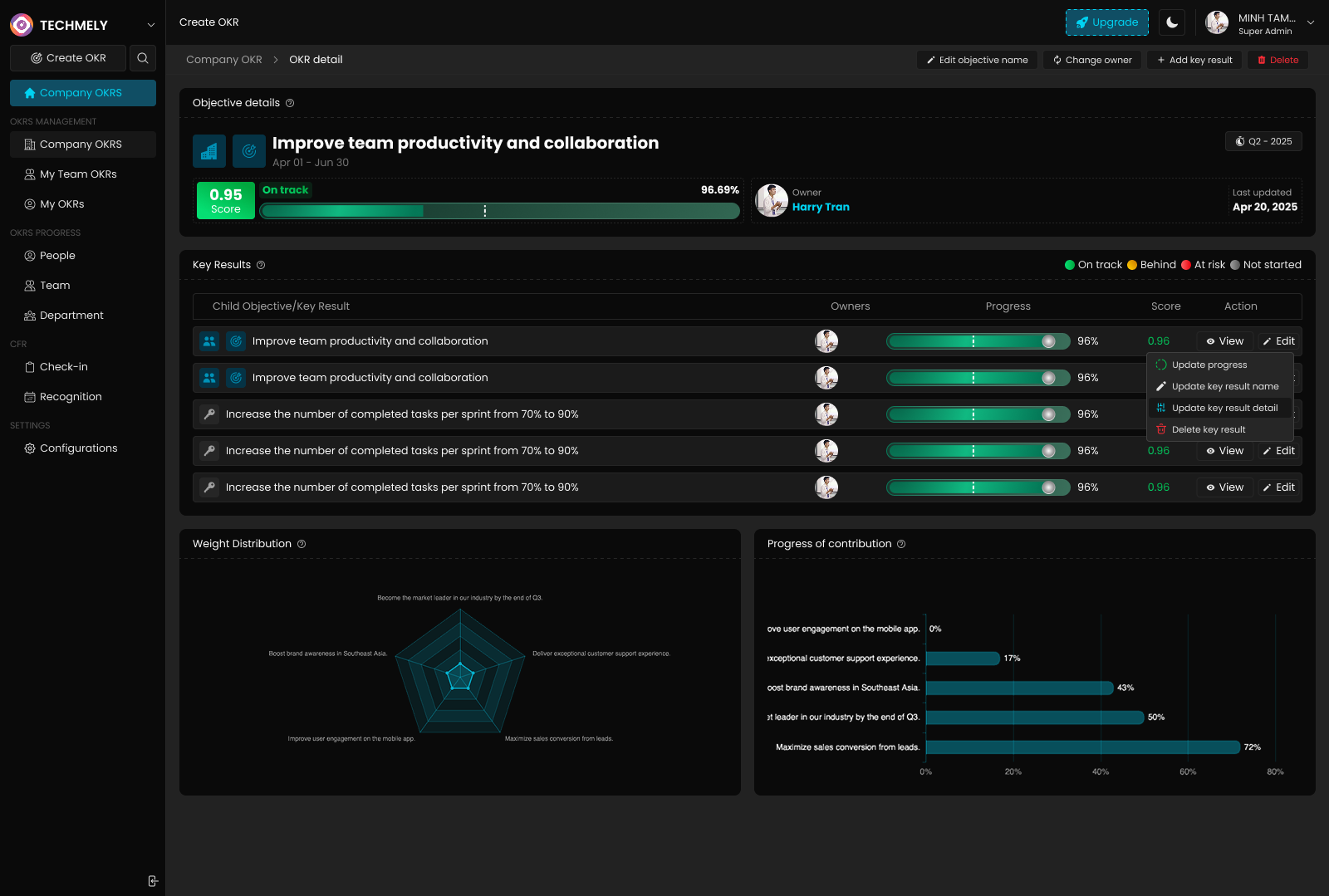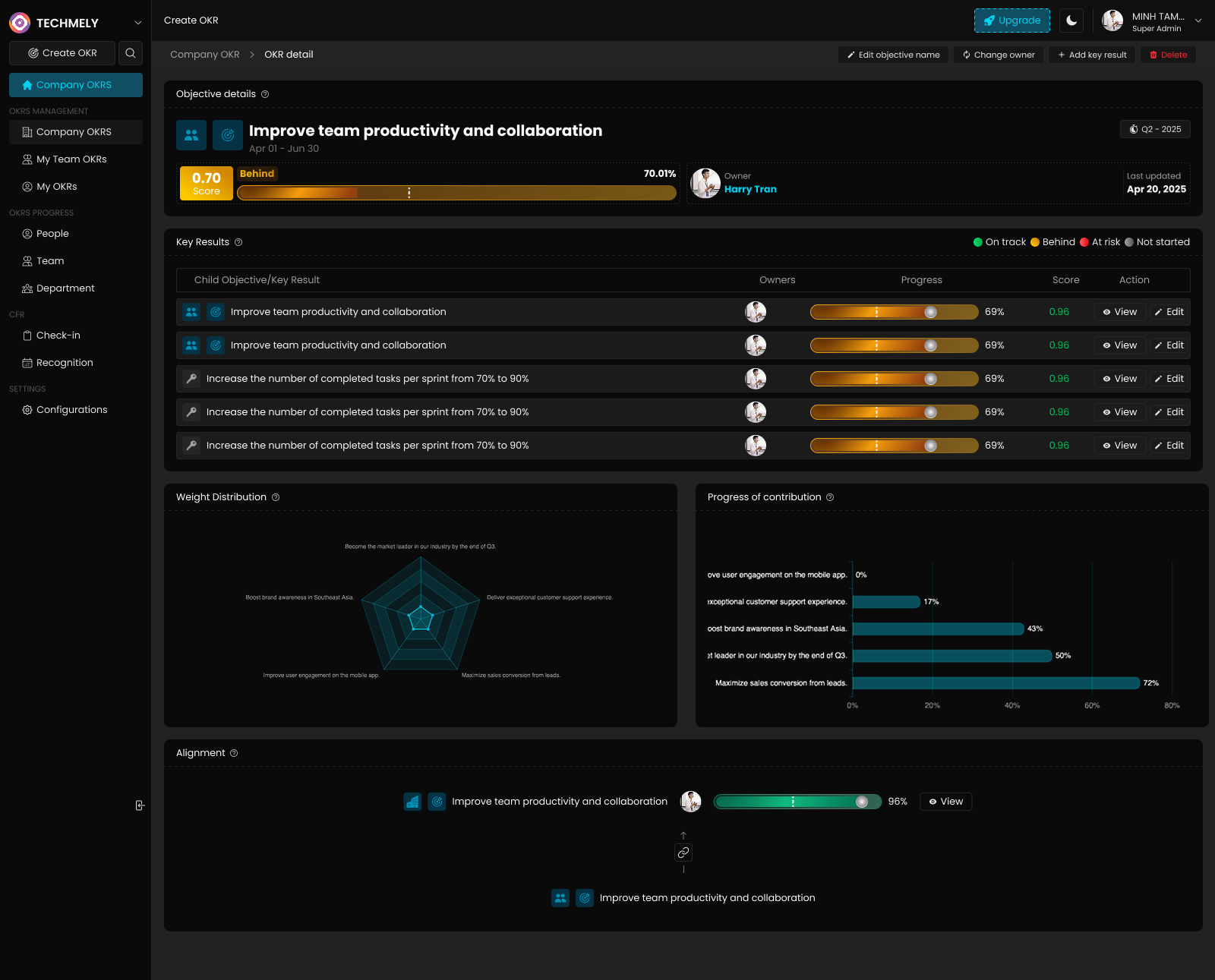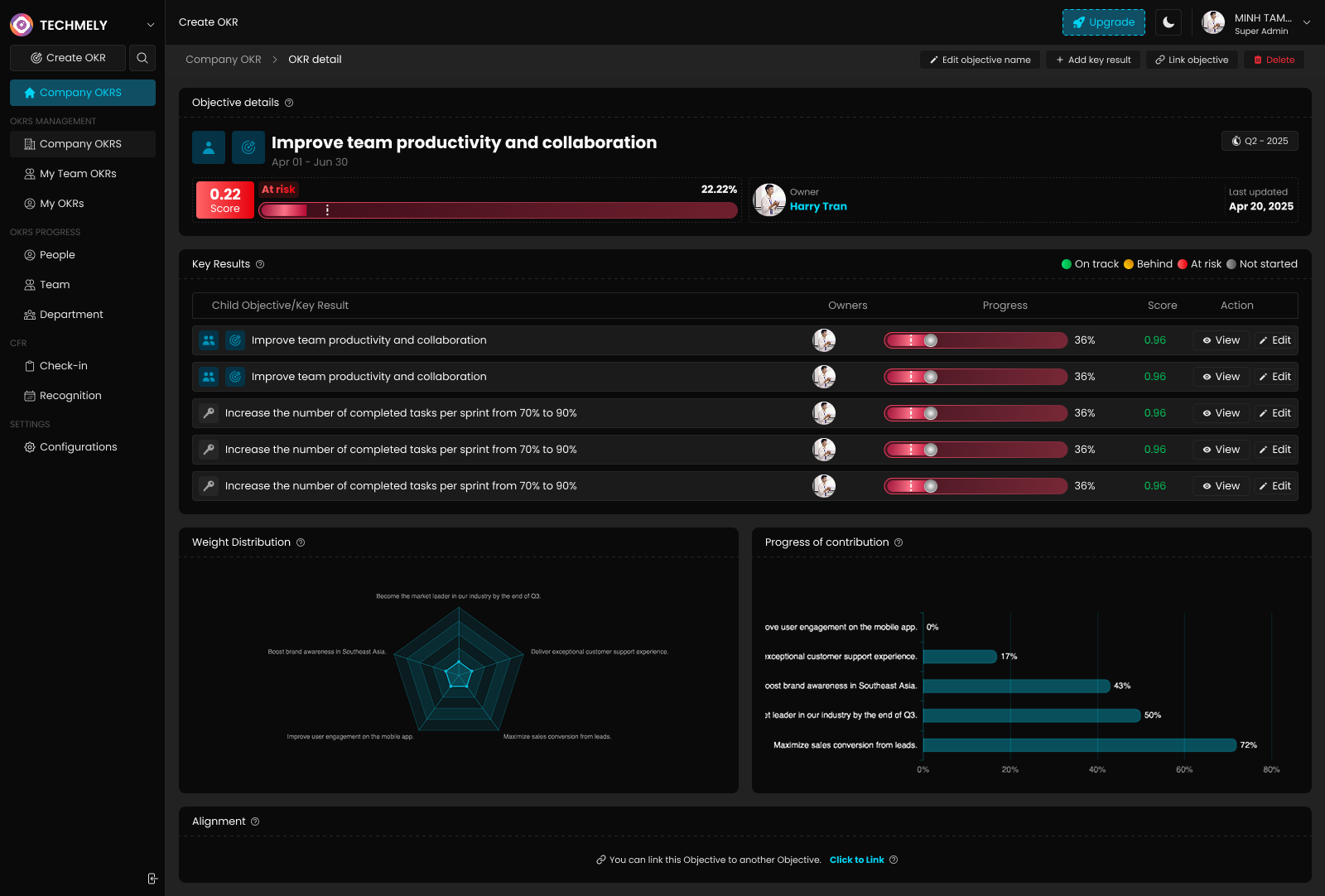View OKR Details
Complete guide to viewing and understanding OKR details across all levels - Company, Team, and Personal
View OKR Details
Overview
The OKR detail view is your command center for monitoring, analyzing, and managing individual objectives and their key results. This comprehensive interface provides deep insights into progress, alignment, and performance across all levels of your organization.
Understanding the OKR Detail Interface
The OKR detail page contains several key sections that help you understand and manage your objectives:
Objective Header
- Objective Title: Clear statement of the goal
- Progress Score: Overall completion percentage
- Status Indicator: Visual health status (On track, Behind, At risk)
- Owner Information: Person responsible for the objective
- Time Period: Quarter and date range
- Last Updated: Most recent modification timestamp
Key Results Section
- Individual Key Results: Specific measurable outcomes
- Progress Bars: Visual representation of completion
- Owners: Responsible individuals for each key result
- Action Buttons: Edit, view, and delete options
Analytics and Insights
- Weight Distribution Chart: Shows relative importance of key results
- Progress Contribution Chart: Visual breakdown of progress sources
- Alignment Section: Links to parent or child objectives
Viewing Different OKR Levels
Company-Level OKR Details
Company OKRs represent the highest strategic priorities and are typically set by senior leadership.

Key Features of Company OKRs:
- Strategic Focus: Broad, organization-wide objectives
- High Visibility: Accessible to all organization members
- Cascade Potential: Can be linked to team and personal objectives
- Executive Ownership: Usually owned by C-level executives or VPs
- Quarterly Tracking: Regular progress reviews and updates
Company OKR Characteristics:
- Progress is typically measured in high-level metrics
- Multiple teams may contribute to single company key results
- Strong alignment with mission and vision statements
- Influence on resource allocation and strategic decisions
Team-Level OKR Details
Team OKRs bridge company strategy with individual execution, focusing on departmental or functional goals.

Key Features of Team OKRs:
- Functional Focus: Specific to team capabilities and responsibilities
- Collaborative Effort: Multiple team members working toward common goals
- Tactical Implementation: More specific than company objectives
- Cross-Team Dependencies: May require coordination with other teams
- Regular Reviews: Weekly or bi-weekly team check-ins
Team OKR Characteristics:
- Clear connection to team's expertise and deliverables
- Measurable outcomes that team can directly influence
- Balance between ambitious goals and realistic capabilities
- Strong ownership and accountability within the team
Personal-Level OKR Details
Personal OKRs focus on individual development, performance, and contribution to team success.

Key Features of Personal OKRs:
- Individual Growth: Skill development and career advancement
- Performance Focus: Personal contribution and achievement
- Learning Goals: Professional development objectives
- Career Alignment: Support for long-term career aspirations
- Self-Management: Individual ownership and tracking
Personal OKR Characteristics:
- Directly within individual's control and influence
- Mix of performance and development objectives
- Clear connection to role responsibilities
- Support for career growth and capability building
Key Sections in OKR Detail View
1. Objective Information Panel

This panel provides comprehensive information about the objective:
Progress Tracking:
- Score: Numerical progress indication (0.00 - 1.00 scale)
- Status: Visual indicator (On track, Behind, At risk)
- Percentage: Completion percentage
- Timeline: Period coverage and deadlines
Ownership and Responsibility:
- Primary Owner: Individual accountable for overall objective
- Team Assignment: Team responsible for execution
- Stakeholders: Other involved parties
Status Indicators:
- 🟢 On Track: Progress meeting or exceeding expectations
- 🟡 Behind: Some delays but recoverable
- 🔴 At Risk: Significant risk of not achieving objective
2. Key Results Management
The key results section shows all measurable outcomes that contribute to the objective:
Key Result Elements:
- Name: Descriptive title of the key result
- Progress Bar: Visual representation of completion
- Percentage: Numerical progress indicator
- Score: Weighted contribution to objective
- Owner: Person responsible for the key result
- Actions: Edit, view, delete options
Progress Calculation:
- Individual key result progress is aggregated
- Weights determine relative importance
- Overall objective score is automatically calculated
- Real-time updates when key results are modified
3. Analytics and Visualization
Weight Distribution Chart
Shows the relative importance and contribution of each key result:
- Radar Chart: Visual representation of key result weights
- Balanced View: Identifies over or under-weighted areas
- Strategic Alignment: Ensures appropriate focus distribution
Progress Contribution Chart
Displays how each element contributes to overall progress:
- Horizontal Bar Chart: Progress breakdown by key result
- Percentage Values: Specific contribution amounts
- Visual Comparison: Easy identification of top contributors
4. Alignment and Linking
The alignment section shows connections with other objectives:
Linked Objectives:
- Parent Objectives: Higher-level goals this objective supports
- Child Objectives: Lower-level objectives that support this goal
- Peer Connections: Related objectives at the same level
Alignment Benefits:
- Strategic Clarity: Clear line of sight to company goals
- Coordination: Better cross-team collaboration
- Impact Visibility: Understanding of contribution to larger outcomes
Navigation and User Interface Elements
Action Buttons and Controls
The OKR detail page includes various action buttons for management:
Primary Actions:
- Edit Objective Name: Modify the objective title
- Change Owner: Reassign responsibility
- Add Key Result: Create new measurable outcomes
- Link Objective: Connect to parent objectives
- Delete: Remove the objective (with confirmation)
Key Result Actions:
- Edit: Modify key result details
- Update Progress: Change completion percentage
- View Details: Deep dive into key result specifics
- Delete: Remove key result (with confirmation)
Status and Progress Indicators
Visual Elements:
- Color Coding: Green (on track), Yellow (behind), Red (at risk)
- Progress Bars: Horizontal bars showing completion percentage
- Score Display: Numerical values for precise tracking
- Icons: Visual indicators for different element types
Understanding Progress Calculation
How Objective Progress is Calculated
Objective progress is automatically calculated based on key result progress and weights:
- Individual Key Result Progress: Each key result has its own completion percentage
- Weight Application: Key results are weighted based on importance
- Aggregation: Weighted average creates overall objective score
- Real-Time Updates: Changes to key results immediately update objective progress
Progress Scenarios
Scenario 1: Equal Weight Key Results
- 3 key results, each weighted equally (33.3%)
- KR1: 80% complete, KR2: 60% complete, KR3: 90% complete
- Overall progress: (80% + 60% + 90%) / 3 = 76.7%
Scenario 2: Weighted Key Results
- KR1: 50% weight, 80% complete = 40% contribution
- KR2: 30% weight, 60% complete = 18% contribution
- KR3: 20% weight, 90% complete = 18% contribution
- Overall progress: 40% + 18% + 18% = 76%
Best Practices for Viewing OKRs
Regular Review Habits
Daily Quick Checks:
- Review progress indicators
- Check for updated key results
- Monitor status changes
- Identify immediate blockers
Weekly Deep Dives:
- Analyze progress trends
- Review key result details
- Update progress where needed
- Plan upcoming activities
Monthly Strategic Reviews:
- Assess overall objective health
- Review alignment connections
- Evaluate resource allocation
- Plan strategic adjustments
Effective Monitoring
Key Metrics to Watch:
- Progress Rate: How quickly objectives are advancing
- Risk Indicators: Early warning signs of potential issues
- Alignment Gaps: Disconnections in the strategic cascade
- Resource Constraints: Bottlenecks affecting progress
Action Triggers:
- Progress falling behind schedule
- Key results consistently missing targets
- Changes in strategic priorities
- Resource or capacity constraints
Troubleshooting Common Issues
Progress Not Updating
Possible Causes:
- Key result progress not being updated
- Synchronization delays
- Calculation errors
Solutions:
- Manually refresh the page
- Check individual key result updates
- Verify weight calculations
- Contact system administrator
Alignment Issues
Possible Causes:
- Broken links to parent objectives
- Misaligned strategic connections
- Outdated objective relationships
Solutions:
- Review linking relationships
- Re-establish broken connections
- Update alignment based on current strategy
- Consult with leadership on strategic changes
Access and Permission Problems
Possible Causes:
- Insufficient user permissions
- Team membership changes
- Role-based access restrictions
Solutions:
- Verify team membership
- Check user permissions
- Contact administrator for access updates
- Review organizational structure changes
Next Steps
After reviewing OKR details, consider these follow-up actions:
- Update Progress: Ensure all information is current
- Take Action: Address any identified issues or blockers
- Communicate: Share insights with relevant stakeholders
- Plan Ahead: Prepare for upcoming milestones and deadlines
- Learn: Capture insights for future OKR planning
Related Topics
- Managing OKR Actions - Learn about editing and updating OKRs
- Change OKR Owner - How to reassign OKR ownership
- Key Result Details - Deep dive into key result management
- OKR Analytics - Understanding progress metrics and insights
The OKR detail view is your primary tool for understanding and managing objective progress. Regular engagement with this interface will help you stay on top of your goals and drive successful outcomes.
Suggested Related Articles
Create Team-Level OKR
Step-by-step guide to creating effective team-level Objectives and Key Results in AntOKR
Login
How to access your AntOKR account
Link Objectives for Strategic Alignment
Complete guide to linking objectives in AntOKR to create strategic alignment and cascade goals across your organization
Department Management
Complete guide to creating, managing, and organizing departments and teams within your AntOKR organization
Team Management
Complete guide to creating, managing, and organizing teams within your AntOKR organization for effective collaboration and OKR execution
Create Personal-Level OKR
Complete guide to creating personal Objectives and Key Results for individual growth and performance